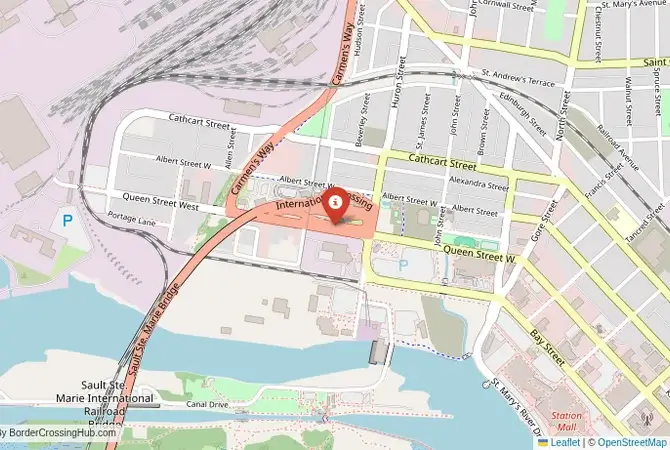
Approximate Border Location
Border Countries
- 🇺🇸United States
- 🇨🇦Canada
Border Cities
- 🇺🇸Sault Ste. Marie, Michigan
- 🇨🇦Sault Ste. Marie, Ontario
Wait Times
15-60 min for pedestrians/vehicles
Operating Hours
Open 24 hours
Crossing Types
Pedestrians, vehicles, commercial
Border Type
Land crossing via bridge
Peak Times
Mornings (7-10 AM), weekends
Daily Crossings
~5000 travelers/vehicles
Currency Exchange
Available near Sault Ste. Marie (USD, CAD)
Safety Information
Generally safe, rural area
Languages Spoken
English
Accessibility Features
Ramps, elevators
About Sault Ste. Marie, Michigan & Sault Ste. Marie, Ontario
A Scenic Great Lakes Crossing
The Sault Ste. Marie border crossing, via the International Bridge, connects Sault Ste. Marie, Michigan, with Sault Ste. Marie, Ontario, using I-75 and Ontario Highway 17. This 24/7 port links Michigan’s Upper Peninsula (2 hours to Marquette) with Northern Ontario (6 hours to Thunder Bay). Known for the Soo Locks, it’s a hub for tourism and light trade, drawing visitors to its scenic waterways. Foreign travelers should check CBP or CBSA updates, as scams and summer congestion can occur.
Historical Background
Established in the 1800s, this crossing tied the Soo Locks’ shipping trade to Ontario’s fur and timber markets. Named for the St. Marys River rapids, it grew with the 1962 International Bridge opening, easing travel. During Prohibition, smugglers navigated the river’s currents, with a 1929 boat chase becoming local legend. The 1980s saw tourism boom with lock tours, and today it handles steady traffic. A 1975 ice jam briefly halted crossings, underscoring the region’s challenging winters and resilient spirit.
Before Crossing
Crossing borders gets messy sometimes, think political flare-ups or gates shutting fast. Good travel insurance is a must for handling doctor visits, trip disruptions, or security scares. Don’t get caught unprepared. To find a policy that’s got your back, check out reliable plans today for peace of mind.
Crossing Details and Wait Times
Northbound, you’ll stop at Michigan’s CBP office for an exit stamp, then reach Ontario’s Canadian immigration, needing a passport and possibly a $7 CAD eTA (apply online). Southbound, expect a Canadian exit stamp and U.S. entry rules, typically a passport for visa-exempt travelers. Open 24/7, passenger waits are 15–30 minutes, but summer weekends or holidays can hit 60 minutes during lock tours or festivals. Check CBSA’s CanBorder app or CBP’s Border Wait Times for real-time updates.
Scam Warnings
Scams are moderate here, with “visa helpers” in Ontario charging $20–$50 for fake services. Bogus “customs offices” may overcharge for forms—stick to CBSA/CBP channels and secure an eTA online. Currency exchange scams near the bridge push poor rates; carry USD/CAD cash or use Michigan ATMs. Pickpocketing risks rise during summer tourism, so secure valuables. Avoid “fast-track” offers—they’re scams targeting travelers in busy seasons.
Transportation Options
From Michigan’s Sault Ste. Marie, it’s a 5-minute drive to the bridge via I-75. From Ontario’s Sault Ste. Marie, Highway 17 connects to Sudbury (4 hours east). Buses like Indian Trails stop in Michigan, but none go directly to the border, so drive or rent a car. Taxis and rideshares are available—confirm fares upfront to avoid surprises. Gas stations and services are in both cities, just 5 minutes away. Pedestrians can cross but need a pickup arranged.
Road Conditions and Views
I-75 and Highway 17 are well-paved but busy in summer with tourist traffic. Winter (November–March) brings heavy snow, requiring snow tires or chains. The St. Marys River and Soo Locks offer breathtaking views, with summer highs of 25°C and winter lows of -15°C. Check Michigan’s 511 or Ontario’s (800) 268-4686 for road updates. Fall foliage and lake vistas create a stunning backdrop, perfect for scenic drives.
Local Sights
Michigan’s Soo Locks Visitor Center, 10 minutes south, showcases Great Lakes shipping history with live ship viewings. Ontario’s Canadian Bushplane Heritage Centre, 10 minutes north, explores aviation with hands-on exhibits. Try Michigan’s hearty pasties at The Antlers or Ontario’s poutine at Muio’s. Whitefish Point, 1 hour south, offers lighthouse tours, while Ontario’s Agawa Canyon, 2 hours north, stuns with scenic train tours through rugged wilderness.
Cultural and Economic Role
This crossing blends Michigan’s outdoor heritage with Ontario’s multicultural charm, evident in shared events like the Soo Locks Festival, drawing crowds with boat parades. It supports tourism and light trade, fueling local economies. Michigan’s lock tours and Ontario’s festivals thrive on cross-border visitors. Community markets, hockey games, and fishing derbies foster a strong binational bond, with locals sharing a passion for the Great Lakes and outdoor adventures.
Travel Tips
Open 24/7, but check CBSA/CBP for holiday schedules. Carry USD/CAD for tolls ($3–$4) or duty-free shops. An eTA saves time for visa-exempt travelers. Winter drivers need snow gear; check Michigan’s 511 or Ontario’s (800) 268-4686 for road conditions. Declare all goods—agents are strict on fish or game. Secure valuables in this busy crossing and pack snacks for potential waits during peak tourist seasons.
Extra Tips for Visitors
Cell service is strong but can drop near the river—download maps ahead. Summer tourism clogs roads; winter snow demands cautious driving. Locals are friendly—ask about 1930s smuggler tales or the locks’ history for fun insights. Try Michigan’s West Pier Drive-In for classic burgers or Ontario’s Muio’s for hearty pasta. Photographers, catch sunrise over the Soo Locks for dramatic shots. This crossing’s scenic charm and rich history make it a Great Lakes gem for explorers.
No reviews yet.
